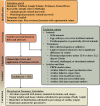Physiological parameter values for physiologically based pharmacokinetic models in food-producing animals. Part II: Chicken and turkey
- PMID: 33289178
- PMCID: PMC8359335
- DOI: 10.1111/jvp.12931
Physiological parameter values for physiologically based pharmacokinetic models in food-producing animals. Part II: Chicken and turkey
Abstract
Physiologically based pharmacokinetic (PBPK) models are growing in popularity due to human food safety concerns and for estimating drug residue distribution and estimating withdrawal intervals for veterinary products originating from livestock species. This paper focuses on the physiological and anatomical data, including cardiac output, organ weight, and blood flow values, needed for PBPK modeling applications for avian species commonly consumed in the poultry market. Experimental and field studies from 1940 to 2019 for broiler chickens (1-70 days old, 40 g - 3.2 kg), laying hens (4-15 months old, 1.1-2.0 kg), and turkeys (1 day-14 months old, 60 g -12.7 kg) were searched systematically using PubMed, Google Scholar, ProQuest, and ScienceDirect for data collection in 2019 and 2020. Relevant data were extracted from the literature with mean and standard deviation (SD) being calculated and compiled in tables of relative organ weights (% of body weight) and relative blood flows (% of cardiac output). Trends of organ or tissue weight growth during different life stages were calculated when sufficient data were available. These compiled data sets facilitate future PBPK model development and applications, especially in estimating chemical residue concentrations in edible tissues to calculate food safety withdrawal intervals for poultry.
Keywords: Food Animal Residue Avoidance Databank (FARAD); blood flow; food safety; organ weight; physiologically based pharmacokinetic (PBPK) model.
© 2020 The Authors. Journal of Veterinary Pharmacology and Therapeutics published by John Wiley & Sons Ltd.
Conflict of interest statement
The authors declare no conflict of interest.
Figures
Similar articles
-
Physiological parameter values for physiologically based pharmacokinetic models in food-producing animals. Part III: Sheep and goat.J Vet Pharmacol Ther. 2021 Jul;44(4):456-477. doi: 10.1111/jvp.12938. Epub 2020 Dec 22. J Vet Pharmacol Ther. 2021. PMID: 33350478 Free PMC article. Review.
-
An Interactive Generic Physiologically Based Pharmacokinetic (igPBPK) Modeling Platform to Predict Drug Withdrawal Intervals in Cattle and Swine: A Case Study on Flunixin, Florfenicol, and Penicillin G.Toxicol Sci. 2022 Jul 28;188(2):180-197. doi: 10.1093/toxsci/kfac056. Toxicol Sci. 2022. PMID: 35642931 Free PMC article.
-
Physiological parameter values for physiologically based pharmacokinetic models in food-producing animals. Part I: Cattle and swine.J Vet Pharmacol Ther. 2020 Sep;43(5):385-420. doi: 10.1111/jvp.12861. Epub 2020 Apr 8. J Vet Pharmacol Ther. 2020. PMID: 32270548 Free PMC article. Review.
-
A web-based interactive physiologically based pharmacokinetic (iPBPK) model for meloxicam in broiler chickens and laying hens.Food Chem Toxicol. 2022 Oct;168:113332. doi: 10.1016/j.fct.2022.113332. Epub 2022 Aug 5. Food Chem Toxicol. 2022. PMID: 35940329
-
Integration of Food Animal Residue Avoidance Databank (FARAD) empirical methods for drug withdrawal interval determination with a mechanistic population-based interactive physiologically based pharmacokinetic (iPBPK) modeling platform: example for flunixin meglumine administration.Arch Toxicol. 2019 Jul;93(7):1865-1880. doi: 10.1007/s00204-019-02464-z. Epub 2019 Apr 25. Arch Toxicol. 2019. PMID: 31025081
Cited by
-
Development and Application of a Physiologically Based Pharmacokinetic Model for Diclazuril in Broiler Chickens.Animals (Basel). 2023 Apr 29;13(9):1512. doi: 10.3390/ani13091512. Animals (Basel). 2023. PMID: 37174549 Free PMC article.
-
Quantitative Morphometric, Physiological, and Metabolic Characteristics of Chickens and Mallards for Physiologically Based Kinetic Model Development.Front Physiol. 2022 Apr 6;13:858283. doi: 10.3389/fphys.2022.858283. eCollection 2022. Front Physiol. 2022. PMID: 35464078 Free PMC article.
-
Infectious Laryngotracheitis Virus and Avian Metapneumovirus: A Comprehensive Review.Pathogens. 2025 Jan 10;14(1):55. doi: 10.3390/pathogens14010055. Pathogens. 2025. PMID: 39861016 Free PMC article. Review.
-
Physiological parameter values for physiologically based pharmacokinetic models in food-producing animals. Part III: Sheep and goat.J Vet Pharmacol Ther. 2021 Jul;44(4):456-477. doi: 10.1111/jvp.12938. Epub 2020 Dec 22. J Vet Pharmacol Ther. 2021. PMID: 33350478 Free PMC article. Review.
-
An Interactive Generic Physiologically Based Pharmacokinetic (igPBPK) Modeling Platform to Predict Drug Withdrawal Intervals in Cattle and Swine: A Case Study on Flunixin, Florfenicol, and Penicillin G.Toxicol Sci. 2022 Jul 28;188(2):180-197. doi: 10.1093/toxsci/kfac056. Toxicol Sci. 2022. PMID: 35642931 Free PMC article.
References
-
- Adeyemi, O., Eruvbetine, D., Oguntona, T., Dipeolu, M., & Agunbiade, J. (2008). Feeding broiler chicken with diets containing whole cassava root meal fermented with rumen filtrate. Archivos De Zootecnia, 57(218), 247–258.


